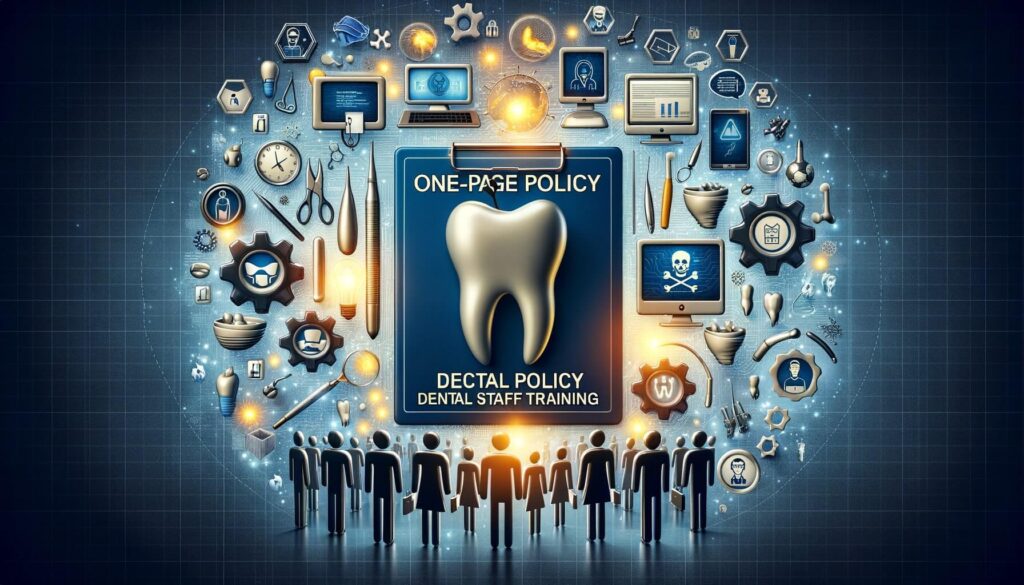In today’s digital age, data breaches and cyber attacks have become increasingly common. Dental practices, like any other business that handles sensitive customer information, are not immune to these threats. Protecting patient data is not only a legal requirement but also crucial for maintaining trust and credibility with patients. One of the most effective ways to ensure the security of patient data is by complying with the Payment Card Industry Data Security Standard (PCI DSS).
This comprehensive set of security standards is designed to protect cardholder data and prevent unauthorized access. In this article, we will explore how dental practices can create a one-page PCI policy for dental staff training to ensure compliance and safeguard patient information.
Assessing PCI Compliance Requirements for Dental Staff Training

Before diving into the process of creating a one-page PCI policy, it is essential to understand the specific requirements for PCI compliance in dental practices. The PCI DSS consists of twelve requirements that cover various aspects of data security. These requirements include maintaining a secure network, protecting cardholder data, implementing strong access control measures, regularly monitoring and testing networks, and maintaining an information security policy.
When it comes to dental staff training, the PCI DSS requires that all employees who handle cardholder data receive training on how to protect sensitive information. This training should cover topics such as the importance of data security, how to identify and respond to potential security threats, and the proper handling of cardholder data. It is crucial to assess these requirements and tailor the training program to meet the specific needs of dental staff.
Developing a Comprehensive One-Page PCI Policy for Dental Staff Training
Creating a one-page PCI policy for dental staff training can be a daunting task, considering the complexity of the PCI DSS requirements. However, by breaking down the policy into key elements and following a step-by-step guide, dental practices can develop a concise and effective policy that is easy to understand and implement.
Understanding the Key Elements of a One-Page PCI Policy

A one-page PCI policy should include the essential elements necessary to ensure compliance and protect patient data. These elements include:
1. Policy Statement: The policy statement should clearly state the dental practice’s commitment to PCI compliance and the protection of cardholder data. It should emphasize the importance of data security and the role of dental staff in maintaining compliance.
2. Scope: The scope of the policy should define the areas and individuals covered by the policy. It should specify which employees are required to undergo training and handle cardholder data.
3. Roles and Responsibilities: This section should outline the specific roles and responsibilities of dental staff regarding PCI compliance. It should clearly define who is responsible for training, monitoring, and enforcing compliance within the practice.
4. Training Requirements: The policy should detail the training requirements for dental staff. It should specify the topics to be covered, the frequency of training, and the methods of delivery.
5. Handling of Cardholder Data: This section should provide guidelines on how dental staff should handle cardholder data. It should cover topics such as data encryption, secure storage, and proper disposal of sensitive information.
6. Incident Response: The policy should outline the procedures to be followed in the event of a data breach or security incident. It should include steps for reporting incidents, mitigating damage, and notifying the appropriate authorities.
Step-by-Step Guide to Creating a One-Page PCI Policy for Dental Staff Training
Creating a one-page PCI policy for dental staff training requires careful planning and attention to detail. The following step-by-step guide can help dental practices develop an effective policy:
1. Familiarize Yourself with PCI DSS Requirements: Before creating the policy, it is crucial to thoroughly understand the PCI DSS requirements. Review the twelve requirements and identify the specific areas that apply to dental practices.
2. Assess Your Current Practices: Evaluate your current data security practices and identify any gaps or areas that need improvement. This assessment will help you tailor the policy to address the specific needs of your dental practice.
3. Define the Policy Statement: Start by crafting a clear and concise policy statement that emphasizes the importance of PCI compliance and the protection of cardholder data. This statement should set the tone for the entire policy.
4. Determine the Scope: Define the scope of the policy by identifying the areas and individuals covered. Specify which employees are required to undergo training and handle cardholder data.
5. Outline Roles and Responsibilities: Clearly define the roles and responsibilities of dental staff regarding PCI compliance. Assign specific individuals or teams responsible for training, monitoring, and enforcing compliance within the practice.
6. Establish Training Requirements: Determine the training requirements for dental staff. Identify the topics to be covered, the frequency of training, and the methods of delivery. Consider using a combination of online modules, in-person sessions, and regular refresher courses.
7. Develop Guidelines for Handling Cardholder Data: Provide clear guidelines on how dental staff should handle cardholder data. Include instructions on data encryption, secure storage, and proper disposal of sensitive information.
8. Create an Incident Response Plan: Outline the procedures to be followed in the event of a data breach or security incident. Include steps for reporting incidents, mitigating damage, and notifying the appropriate authorities.
9. Review and Revise: Once the policy is drafted, review it carefully to ensure clarity and accuracy. Seek input from key stakeholders, such as IT professionals and office managers, to ensure that all aspects of PCI compliance are adequately addressed.
10. Communicate and Train: Once the policy is finalized, communicate it to all dental staff and provide comprehensive training on its contents. Ensure that all employees understand their roles and responsibilities in maintaining PCI compliance.
Training Dental Staff on PCI Compliance: Best Practices and Strategies

Training dental staff on PCI compliance is a critical step in ensuring the security of patient data. Here are some best practices and strategies to consider when implementing a training program:
1. Tailor Training to Job Roles: Different job roles within a dental practice may have varying levels of involvement with cardholder data. Tailor the training program to address the specific needs and responsibilities of each role.
2. Use a Variety of Training Methods: Incorporate a mix of training methods to cater to different learning styles. Consider using online modules, in-person sessions, role-playing exercises, and quizzes to engage dental staff and reinforce key concepts.
3. Provide Regular Refresher Courses: PCI compliance training should not be a one-time event. Schedule regular refresher courses to reinforce knowledge and keep dental staff up to date with the latest security practices.
4. Make Training Interactive: Engage dental staff by making the training sessions interactive. Encourage questions, discussions, and real-life scenarios to enhance understanding and application of PCI compliance principles.
5. Offer Incentives: Consider offering incentives, such as certificates of completion or recognition, to motivate dental staff to actively participate in training and demonstrate their commitment to PCI compliance.
Implementing and Enforcing the One-Page PCI Policy in Dental Practices

Creating a one-page PCI policy is just the first step. Implementing and enforcing the policy within the dental practice is equally important to ensure compliance. Here are some strategies to consider:
1. Clearly Communicate the Policy: Ensure that all dental staff are aware of the policy and understand its contents. Provide copies of the policy to each employee and make it easily accessible for reference.
2. Train New Employees: Incorporate PCI compliance training into the onboarding process for new employees. Make it a mandatory part of their training to ensure that they are aware of the policy from the beginning.
3. Regularly Monitor Compliance: Implement regular monitoring procedures to ensure that dental staff are adhering to the policy. Conduct periodic audits and spot checks to identify any areas of non-compliance and take appropriate corrective actions.
4. Enforce Consequences for Non-Compliance: Clearly communicate the consequences of non-compliance with the policy. Establish disciplinary measures for employees who fail to adhere to the policy, such as verbal warnings, written warnings, or even termination in severe cases.
5. Provide Ongoing Support: Offer ongoing support and resources to dental staff to help them maintain compliance. Provide access to training materials, FAQs, and a designated point of contact for any questions or concerns related to PCI compliance.
Monitoring and Evaluating the Effectiveness of Dental Staff Training on PCI Compliance
Monitoring and evaluating the effectiveness of dental staff training on PCI compliance is crucial to ensure continuous improvement and identify any areas that need further attention. Here are some strategies for monitoring and evaluating training effectiveness:
1. Conduct Regular Assessments: Administer regular assessments or quizzes to evaluate dental staff’s understanding of PCI compliance principles. Use the results to identify any knowledge gaps and provide targeted training to address those gaps.
2. Monitor Compliance Metrics: Track compliance metrics, such as the number of reported incidents, the frequency of security audits, and the completion rates of training courses. Analyze these metrics to identify trends and areas for improvement.
3. Seek Feedback from Dental Staff: Encourage dental staff to provide feedback on the training program. Conduct surveys or interviews to gather their opinions on the effectiveness of the training and any suggestions for improvement.
4. Review Incident Reports: Regularly review incident reports to identify any recurring issues or patterns. Use this information to update training materials and reinforce specific areas of concern.
5. Stay Updated with Industry Best Practices: Stay informed about the latest industry best practices and changes in PCI compliance requirements. Regularly review and update the training program to align with these changes and ensure ongoing compliance.
Frequently Asked Questions (FAQs)
Q1. What is PCI compliance, and why is it important for dental practices?
A1. PCI compliance refers to adhering to the Payment Card Industry Data Security Standard (PCI DSS), a set of security standards designed to protect cardholder data. It is important for dental practices to maintain PCI compliance to protect patient data, maintain trust with patients, and avoid legal and financial consequences.
Q2. Who is responsible for PCI compliance in a dental practice?
A2. PCI compliance is a shared responsibility among all employees in a dental practice. However, it is crucial to designate specific individuals or teams responsible for training, monitoring, and enforcing compliance within the practice.
Q3. How often should dental staff undergo PCI compliance training?
A3. PCI compliance training should be conducted regularly, with refresher courses scheduled at least annually. The frequency of training may vary depending on changes in PCI DSS requirements and the specific needs of the dental practice.
Q4. What are the consequences of non-compliance with PCI policies?
A4. The consequences of non-compliance with PCI policies can vary depending on the severity of the violation. Consequences may include verbal or written warnings, additional training requirements, or even termination in severe cases.
Q5. How can dental practices ensure ongoing compliance with PCI requirements?
A5. Dental practices can ensure ongoing compliance with PCI requirements by regularly monitoring compliance metrics, conducting assessments, staying updated with industry best practices, and providing ongoing support and training to dental staff.
Conclusion
Creating a one-page PCI policy for dental staff training is a crucial step in ensuring the security of patient data and maintaining compliance with PCI DSS requirements. By understanding the importance of PCI compliance, assessing the specific requirements for dental staff training, and following a step-by-step guide, dental practices can develop a comprehensive policy that is easy to understand and implement.
Training dental staff on PCI compliance best practices and strategies, implementing and enforcing the policy, and monitoring and evaluating training effectiveness are essential for maintaining ongoing compliance and safeguarding patient information. By prioritizing PCI compliance and investing in staff training, dental practices can protect their patients’ data and maintain trust in an increasingly digital world.
